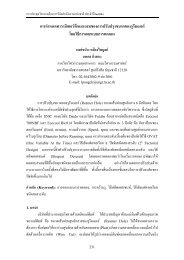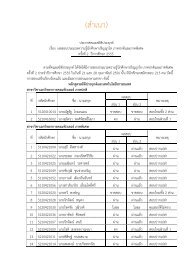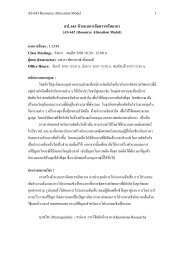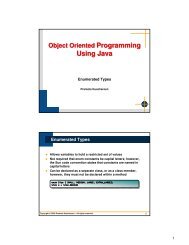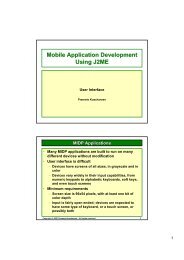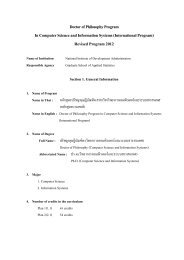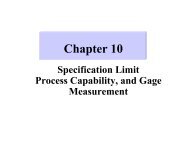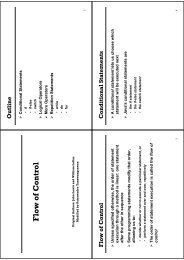ดาวน์โหลด All Proceeding - AS Nida
ดาวน์โหลด All Proceeding - AS Nida
ดาวน์โหลด All Proceeding - AS Nida
Create successful ePaper yourself
Turn your PDF publications into a flip-book with our unique Google optimized e-Paper software.
Table 12. Comparison on Circuit Width.<br />
Item<br />
Top Circuit Width<br />
Before After<br />
Bottom Circuit Width<br />
Before After<br />
Mean 0.074 0.075 0.097 0.099<br />
SD 0.0017 0.0012 0.0026 0.0024<br />
3σ 0.005 0.004 0.008 0.007<br />
Cpk -3.03 -3.57 0.85 1.19<br />
5. CONCLUSIONS AND RECOMMENDATIONS<br />
In this paper the proper factorial experiments, multiple<br />
regression and mathematical programming approaches are applied to<br />
investigate the preferable levels of significant process variables in order<br />
to improve the quality of etched rate. Firstly, the 2 k factorial design was<br />
applied to preliminarily study the effects of those three factors. The<br />
responses which consist of circuit widths (RCW) and etching rate (RER) from the preset experimental designs are measured by Hand-Held<br />
Instruments of the Eddy current method. The multiple regression<br />
models of those responses were then developed from only significant<br />
factors affecting each response. Finally, the regression model of RCW in<br />
forms of the path of steepest descent was placed as the objective<br />
function of the linear constrained response surface optimisation model<br />
to minimise the circuit width subject to the remaining response and the<br />
limitation from feasible ranges of two main factors. However, in this<br />
study the RCW could be interchangeable to be only the model constraint<br />
and the RER is formulated as the response instead.<br />
After an implementation, the experimental results on top and<br />
bottom circuit widths were analysed via t-tests (Table 13). The new<br />
condition statistically affects on both top and bottom widths at 95%<br />
confidence interval. There is a decrease in the deviation from a<br />
customer requirement as appeared in the Box-Whisker plots (Fig. 11<br />
and 12). This research was scoped only on one the product and product<br />
layout. Consequently conclusions may not be globally optimal.<br />
However, the sequential procedures can be applied to the FPC<br />
manufactures with many circuit width designs and limited machine<br />
capabilities.<br />
58<br />
Data<br />
Data<br />
0.077<br />
0.076<br />
0.075<br />
0.074<br />
0.073<br />
0.072<br />
0.071<br />
Pattern position<br />
0.090<br />
Pattern position<br />
Boxplot of Top width (before), Top width (After)<br />
MT C1 C2 OP<br />
Top width (before)<br />
MT C1 C2 OP<br />
Top width (After)<br />
Fig.11 Box-Whisker Plot of Top Circuit Width.<br />
Boxplot of Bottom width (before), Bottom width (After)<br />
0.104<br />
0.102<br />
0.100<br />
0.098<br />
0.096<br />
0.094<br />
0.092<br />
MT C1 C2 OP<br />
Bottom width (before)<br />
MT C1 C2 OP<br />
Bottom w idth (After)<br />
Fig.12 Box-Whisker Plot of Bottom Circuit Width.<br />
Table 13. Comparison via Two Sample T-tests.<br />
Circuit Width T-Stat P-Value<br />
Top -2.76 0.008<br />
Bottom -4.03 0.000<br />
ACKNOWLEDGMENT<br />
The authors wish to thank the Faculty of Engineering,<br />
Thammasat University, THAILAND for the financial support.<br />
REFERENCES<br />
[1] Luangpaiboon, P. and Peeraprawit, N. (2009), “Nonlinear<br />
Constrained Steepest Ascent Method for a Laser Welding<br />
Process”, The Journal of Industrial Technology, Vol. 5, No. 1, pp.<br />
18-25.<br />
[2] Luangpaiboon, P., Suwankham, Y. and Homrossukon S. (2010),<br />
“Constrained Response Surface Optimisation for Precisely<br />
Atomising Spraying Process”, IAENG Transactions on<br />
Engineering Technologies, Vol. 5, pp. 286-300. DOI:<br />
10.1063/1.3510555




